 by Liz Hessen of For the Love of Chicken Poop
by Liz Hessen of For the Love of Chicken Poop
When it comes to adding to your flock every situation is different. Some attempts work right away, some attempts work after a very long time, some, you feel, will NEVER work..no mater how much you love very last one of them!
ADOPTING CLAUDINE –
We got Claudine, a two year old gorgeous buff orpington,from a neighbor who was down to one chicken after various losses of the original four. They have a new baby and decided it would be better at that time to try and re-home her instead of adding new chickens. Claudine did seem lost without other chickens around. Already smitten we said we’d add her to our established one year old flock of six (easier said than done)!
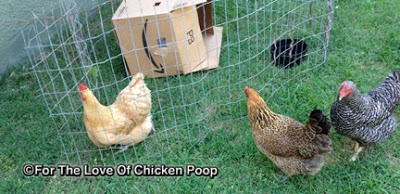 |
| What the…? |
THE PLAY DATE –
We brought Claudine down for a play date with our flock on a Saturday. We made a fenced play area for her and let her into that first. Very casually we let our flock out to wander around and ‘discover‘ her. We left part of the fence open so she could go out when she was ready. Carmen was the first to see her and in a flash she went from sweet little chicken to a hovering scary dinosaur. Raquel was the next to approach her. Flapping her wings and hissing (yes chickens hiss). Talulah jumped on her, pecking and wing-flapping, and made her loud warning shriek which is usually used when hawks are seen. The Hepburn sisters, our two barred rocks (who are easy going by breed) ran over just to make sure she wasn’t getting their share of treats. At that point Claudine retreated to higher ground -the patio table). This may sound a lot worse than it really was but there were no feathers lost or blood shed in this first meet up.The play date went on for a couple of hours and then Claudine returned home to sleep in her own coop one last night.
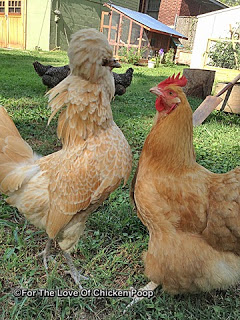 |
| Carmen doing her dinosaur imitation. |
Sunday morning we brought Claudine down for the permanent move. What we deliriously thought would be an interesting experience for us and a great new playmate for the other chickens (the Brady Bunch with feathers). Before the day was over Harry ended up getting he her coop and run from the owners – thank goodness a portable style! We set it up in a place where they could all see each other. It would have been better if the runs could have been side by side but with the layout of our yard it was impossible.
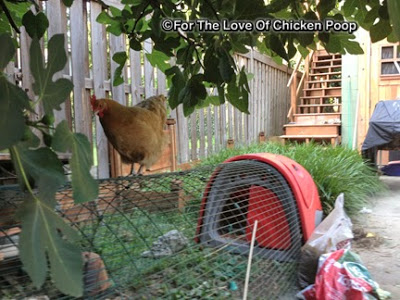 |
| Claudine on her own higher ground ! |
GIVE HER A PLACE IN WHICH SHE CAN ESCAPE OTHERS –
The higher ground now was the top of Claudine’s run. We’d leave the door to the temporary run open so everyone can visit and check things out, once again so they could see she was no threat to them.
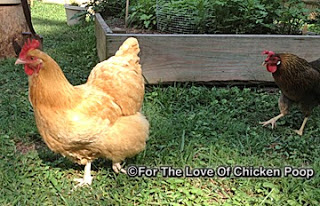 |
| Julie doesn’t realize how BIG Claudine is ! |
PATIENCE, CONSISTENCY (AND ADULT BEVERAGES FOR THE HUMANS) –
On the week days Harry took the early morning and evening shifts supervising Claudine while she foraged by herself. The little dinosaurs watched from their run, squawking ‘no fair, no fair ‘(hey, they got great treats for staying in) . It took a few mornings and evenings of doing this before she finally relaxed and started wandering about, doing her chicken thing.
I did the mid-morning, lunch and mid afternoon sessions, letting Claudine out to forage on her own for a few minutes, then letting the rest out. While sitting on a tree stump, in the middle of the backyard, I would play wild animal tamer to our flockers and Claudine! Not helping at all was the fact that this took place during several weeks of severe heat.
We had our weekday schedule worked out very well. We planned to double-team on the weekends and get these flockers holding wings and singing songs… How hard can it be to get chickens to love one another?
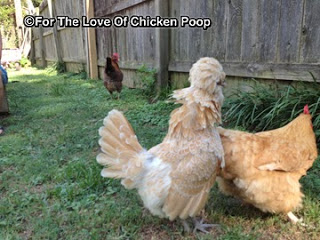 |
| They’ll eventually work it out. NOT! |
HOLD AND PET NEWCOMER A LOT –
At the suggestion of an experienced chicken keeping friend I made sure the flockers saw me holding Claudine a lot, petting her, talking to her. The theory being, since I was the ultimate flock leader to them, if they saw ME playing with Claudine then she must be no threat to them.
CONSTANTLY ENCOURAGE MINGLING –
We did try to take Claudine into the flockers’ run, frequently, and let her hang out in there. Mostly she stayed on the highest perch. A few times she did venture up into the coop area. Most of these visits ended with her being chased out by one of the other flockers.
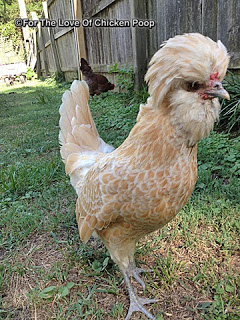 |
| Those dilated pupils tell the whole story. |
REMOVE THE BULLY –
Starting about the fourth week Carmen was really turning into a big bully. Every attempt Claudine made to go into the main coop to lay an egg was loudly and viciously blocked by Carmen. When she needed to lay an egg and couldn’t get to her little nest in the portable coop she’d lay them elsewhere, like the dust bathing area or the middle of the flockers’ run – when they weren’t around!
Time-out for the bully! Several chicken keeping friends said separating the bully, Carmen, from everyone for a night or two would knock her down a notch or two in the pecking order. So Carmen spent the night in Claudine’s coop/run. Claudine spent an uneventful night in the coop with the flockers. Since Claudine was used to lower roosting spot we mounted a low perch and laid a limb on the coop floor…ANYTHING to make her feel more comfortable. She was still nervous even though Carmen was no where in sight!
Carmen survived her night in time-out, even through a huge rain storm. By morning she was not quite as hyper-anxious as she was the night before. She was, though, soaking wet and muddy as heck and I don’t know if the wet and dirty part was hard on her dignity and helped knock her down a few levels in the pecking order or the confinement . The fact that it rained on an off all day didn’t give us a lot of free range time. About mid-day I put Claudine back in her temporary coop and Carmen went back to the main compound with strict orders to BEHAVE!
Carmen’s doing hard time, in the end, did not really make any difference. She saw Claudine trying, one more time, to go in the coop and lay an egg. She FLEW into the coop area and, in no uncertain terms, told Claudine to go away. I’m pretty sure there were a lot of words used that I can’t post on this G rated blog!
 |
| Safe? |
ASK FOR HELP FROM THOSE WITH EXPERIENCE –
We read, researched, made frantic phone calls and texted to other chicken keeping friends. We did it all, tried suggestions (within reason) from everyone . It was not going to work – no matter had badly we wanted it too. For her own safety and well being we had to re-home Claudine. Which, fortunately, turned out the easiest of the whole ordeal! She went to a friend who only lives a few blocks away (bless you Leanne). She is now with even more chicks than our six, room to run and hide if she was bullied and a rooster. Moving, AGAIN, seemed to not bother her at all. She fell right in with the rest of the flock, doing her chicken thing, going up to roost, letting no one bully her! I was visiting them the other day and was told by Leanne that Claudine had actually moved herself up a couple of notches from the bottom of the pecking order…
YOU DON’T REALLY FAIL –
So what did Leanne have that we didn’t? A rooster, more room to hide, even MORE chickens? Who knows! But she is getting, thank goodness, as much love as we were giving!
I realize now there are no tried an true ways for incorporating a chicken/s into your flock. The purpose of this blog is to pass on education and experiences as new (a little over a year now) chicken keepers. Adopting Claudine did not work out as we planned. We made great foster parents though, saving Claudine from loneliness and who knows what else! Even know how it turned out I/we would probably do it over again.
For the love of everything,
Liz-













3 Comments
Hi Liz, I have been told it is best to introduce more than 1 bird to an existing flock as a single bird gets picked on by everyone.
I introduced 3. After spending the typical time in the brooder and they were feathered out enough, I placed the 3 new girls inside of a very large wire kennel in the protected run area 6ft x 8 ft. The run was connected to an indoor coop with nest boxes the old girls would roost in at night. The could interact safely protected by the wire separating the 2 groups. Eventually the new girls were outgrowing the kennel and it was time to let them join the others. I tried just opening the kennel door but it just trapped the new girls from escaping the wrath of the old girls. I eventually disassembled the wire kennel but kept 2 of the sides connected together staked up creating a sort of maze in the run. I also added some roosts changing the run enough to make it feel different to the older girls. I had 2 feed and watering areas so everyone had access. The maze created an avenue for escape from an attacker. Luckily this worked until the spring when I could let everyone out to free range. The older girls continued to roost in the indoor coop and the new girls roosted in the run for several months until they were finally accepted by the original girls.
I started a small flock of mixed bantam chickens. Free ranging didn’t work out — free-ranging neighbor dogs and other predators put a stop to that. I did start a lot of chicks in the incubator, and later in chick boxes I built in the barn. The best luck I had introducing half-grown chicks to the adult flock involved one of the cages I brought the first chickens home in.
About lunch time or mid afternoon, I stick 3-6 candidates in the cage — maybe 2 feet by 18 inches by 18 inches, of hardware cloth, with a water dish. This doesn’t give them a lot of room, but is just for the night. I set the cage in the coop on the floor in front of the roosts, and leave them overnight (re-checking the water doesn’t hurt). The next morning, turn them loose. Typically the youngsters huddle in a corner, and will take several days to join the roost bunch. But the overnight stay dramatically reduced my losses and injuries. The cage protects against any initial flock antagonism, and coming into the flock at “ground” level seems to stand the youngsters in good stead.
I confess that I don’t consider the flock as pets, but as livestock. They deserve my conservation and respect, and I honor that. Waking up with the newcomers already in the coop seems to establish a sense of community. After the coop hens get about their daily routine, I turn the youngsters loose and leave them to work it out for themselves.
We had a small flock and inherited a few more when friends moved out of the country. Chaos and violence ensued. Integrating them was impossible—until our little rooster handled the situation. He ran back and forth all day long between the two flocks, tirelessly, back and forth back and forth…and something amazing happened: it turned out he was like a shoe-lace. As he ran back and forth each time he pulled the flocks ever-so-slightly closer together until they were one. It took quite some time and effort (maybe three weeks?) and then, the flock was one. Masterful little guy.